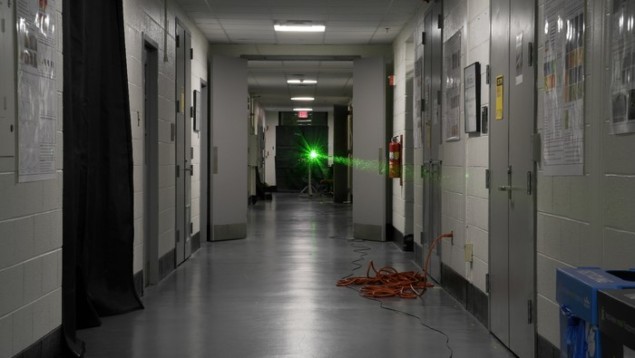
An optical fibre is ideal for transmitting information over long distances because its optical properties ensure that light pulses remain inside the fibre, even if the fibre curves around a corner. However, it would sometimes be convenient to do optical communications over long distances without the hassle of using a fibre. Military communications and weapons guidance systems, for example, could benefit from sending data-encoded optical pulses through the air. The problem is that the pulses spread out laterally as they travel and may not have high enough intensities to be detected by the recipient.
Now, Howard Milchberg and colleagues at the University of Maryland have found a possible solution to this optical spread by firing a powerful laser 45 m along the corridor of a campus building. Their scheme involves firing a repeating cylindrical pattern of intense pulses along the corridor. The pulses heat the air that they travel through, dispersing the air and creating a region of lower density. The overall effect is to create a pipe of low density air that surrounds a core of unperturbed air at higher density.
This creates an optical waveguide that acts much like an optical fibre. To test its efficacy at transmitting information, the team fired much weaker light pulses through the core of the waveguide. They found that about 20% of the light that would otherwise be lost was transmitted over 45 m.
Blazing a kilometre-long path
Milchberg says that the experiment “blazes the path for even longer waveguides and many applications”. He adds, “Based on new lasers we are soon to get, we have the recipe to extend our guides to one kilometre and beyond”.
The research is described in a paper that has been accepted for publication in Physical Review X.
If there is one type of music that should defy description by physicists, jazz would be my candidate. The genre thrives on the improvisation and spontaneity of musicians, something that I assumed would be very difficult to describe using equations.
But the German physicist Theo Geisel has found otherwise in a study of how the members of jazz ensembles use tiny deviations in the relative timings of the notes they play. They found that these variations on the downbeat are responsible for “swing”, that essential yet intangible quality that the jazz bassist Christian McBride describes as a “feel”.
You can read more about the physics of jazz – and listen to McBride demonstrate swing – in this article on the NPR website, “What makes that song swing? At last, physicists unravel a jazz mystery”.



